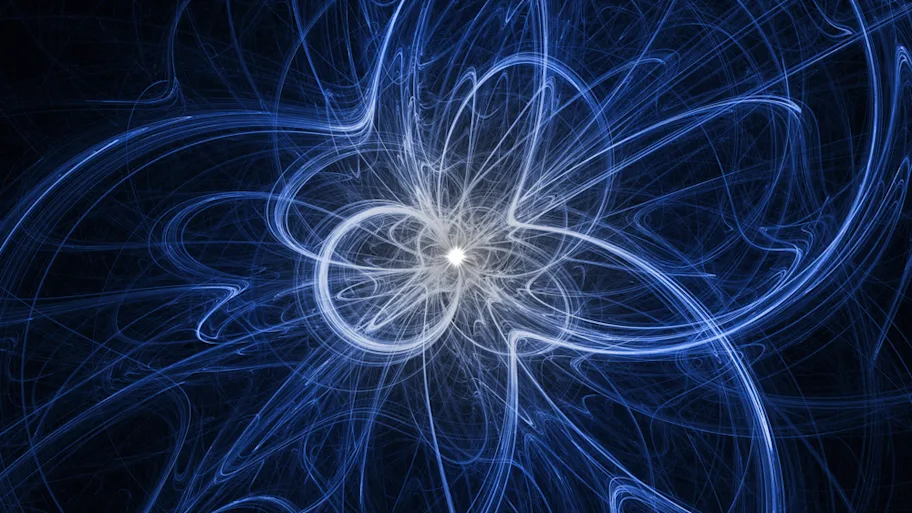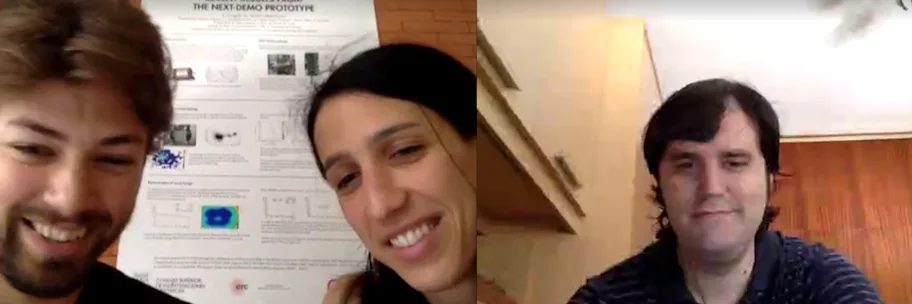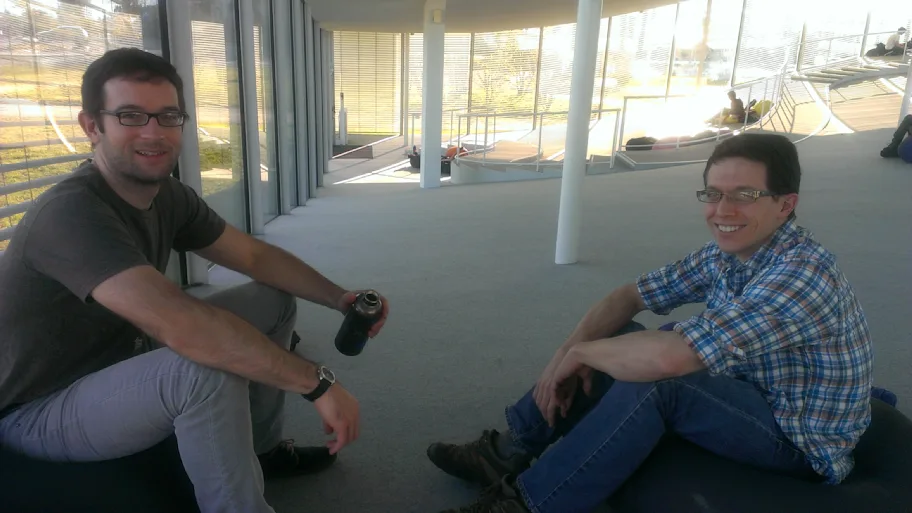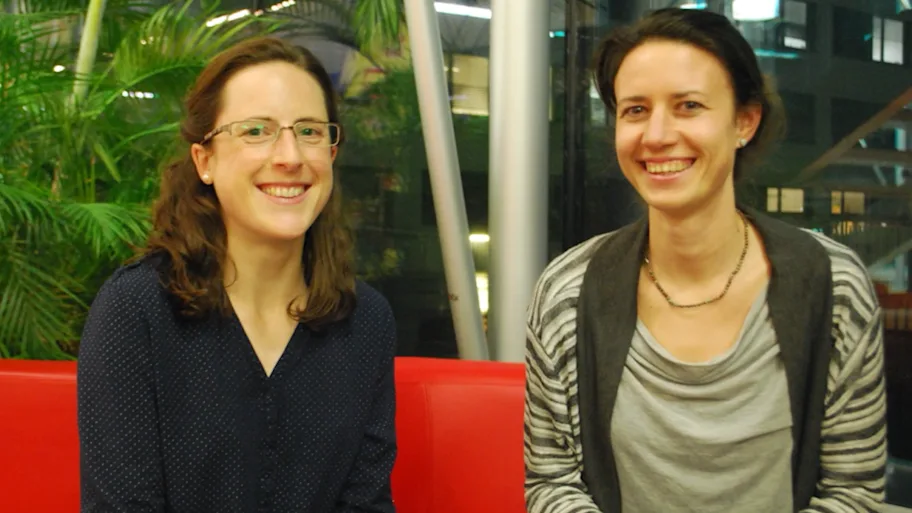
- Science News
- Frontiers news
- 3 young physicists hunting neutrinos
3 young physicists hunting neutrinos
We dive into the Early Career Insights section with a triple interview with particle physicists Dr. Andrew Laing (Scottish, doing his second postdoc), Dr. Paola Ferrario (Italian, doing her first postdoc) and Dr. Justo Martín-Albo (Spanish, recently graduated PhD). They work together at IFIC in Valencia (Spain) searching for neutrinoless double beta decays in the NEXT experiment.
We met during a lunch break, when they had some time for a phone call to do this interview.

Dr. Andrew Laing, Dr. Paola Ferrario and Dr. Justo Martín-Albo during the interview.
With NEXT, the Neutrino Experiment with a Xenon TPC, they seek to understand the nature of the mass of the neutrino. Neutrinos are neutral weakly-interacting fundamental particles which were originally believed to be massless. The discovery of non-zero masses (established by the phenomenon of neutrino oscillations, which will be the topic for a later interview) for these particles is forcing theorists to extend the Standard Model of Particle Physics. Furthermore, neutrinos could be truly neutral or Majorana particles, that is, indistinguishable from their antiparticles. And NEXT is one of the experiments trying to elucidate this open question.
The NEXT experiment is devoted to the search of neutrinoless double beta decay, a postulated radioactive process in which two neutrons inside a nucleus of some radioactive isotopes, like 136Xe, transform into two protons emitting two electrons but no neutrinos. If this process is discovered, it would demonstrate that neutrinos and antineutrinos are the same particle. The NEXT detector consists of a chamber filled with high-pressure enriched Xenon, which will be located at the Underground Laboratory in Canfranc, Spain.
Thanks for participating in this set of interviews. I would like to start asking you how you first got interested in particle physics, and how you decided to start a PhD and doing research.
A: Accidentally… When I finished my undergraduate studies I didn’t have a clear idea of what I wanted to do next and I found an interesting opportunity in the same department of my University so I decided to stay and do my PhD.
J: I had always been interested in doing research and when I finished my undergraduate studies I was in two minds whether to continue with Astrophysics or Particle Physics. After some discussion with my later PhD advisor, I decided on Particle Physics.
Paola, you actually did your PhD in theoretical particle physics (QCD), what made you decide to change to do research in experimental neutrino physics?
P: During my Physics undergraduate studies I found the possibility to describe the reality with mathematical models very exciting. Particle Physics in particular is a field in which these theoretical frameworks appear connected to reality in the sense that current experiments are proving those models. Therefore I did my undergraduate dissertation and later my PhD in theoretical Particle Physics.
But during my PhD, I realized the approach followed by this kind of phenomenological research was somehow different to what I expected, and that it is based on intuitively applying small modifications to your model and making predictions that might be tested in the future. I didn’t like the experience that much.
So I considered changing fields. I was still interested in Particle Physics, as it is the description of the most fundamental elements of the Universe and ourselves. Then, after my PhD I had the possibility to join this group and work in experimental Neutrino Physics and it was a good opportunity. I enjoy the feeling of contributing in the day-by-day development of the experiment.
With NEXT you are searching for neutrinoless double beta decay in Xenon. Why is this measurement important and what would be the implications of discovering this hypothetical process?
J: It is important because it is the only type of experiment which lets us understand the nature of neutrino masses. The implications of discovering this process would be a Majorana neutrino mass, meaning a new type of matter, and the violation of total lepton number. This, in turn, is related to the matter-antimatter asymmetry observed in the Universe.
A: Another nice thing it is that, although the experiment we are doing is very much terrestrial, there is overlap with cosmological experiments which are currently producing more precise measurements. This means a nice interaction with this emerging science and implies the possibility to learn from each other in case of conflict.
How is NEXT different from other neutrinoless double beta decay experiments?
A: There are various isotopes which could possibly exhibit this property, and therefore there are different detectors using different isotopes. There are another three or four experiments using Xenon, and the difference with respect to them is the way you measure the information of the decay.
J: Exactly, the key difference is the detection technique. There is also the possibility of expanding this technique to larger detectors as the sensitivity of these kinds of experiments is basically proportional to the amount of mass of isotope used. We believe our technique should allow us to push forward the limits of scalability.
NEXT has been constructed at the underground laboratory in Canfranc. What is the present status of the experiment?
P: We are about to start running with the first stage of the experiment, called NEW, which contains 10 kg of enriched Xenon. It is going to be useful to measure the background model as it will take place underground in Canfranc.
A: This stage will help us to understand the resolution and reconstruction better as the detector is larger than the prototypes used so far.
You built prototypes at IFIC and Berkeley. What did you learn from them? Did the results obtained with them modify the initial design/plan for NEXT?
P: We learned about details which are important. We were perhaps not paying so much attention to them at the beginning, like the distance between different components of the detector (the tracking plane and the electroluminescence region) or the light collection.
J: I would say that nothing fundamental has changed, but we have learned more about the details of the technique. They served principally to demonstrate that the concept of the detector is suitable for the measurement we want to do, that we can have a very precise measurement of the energy of the events and that we can reconstruct the tracks of the electrons emitted in the decay.
Can you briefly describe the tasks of the experiment you are currently working on?
J: I have been mainly involved from the beginning in the development of the software for the detector, and I have also worked on its design and data analysis.
P: Similarly, my work is focused on the Monte Carlo simulations, reconstruction and data analysis.
A: Since I started later than them, I first explored the code already written and helped to improve the reconstruction, and our understanding of the energy resolution and other secondary effects in the calibration of the different components. Now I am coordinating the construction at Canfranc and the flow of people working there. I will spend next month there working in the clean room.
Do you all have the opportunity to combine work in the lab with computing and analysis? Which part do you enjoy most?
A: From September this year, all members of the collaboration must spend some time in the Underground Laboratory in Canfranc doing data acquisition shifts and helping with the hardware and electronics work. Personally, I enjoy doing both types of work.
J: I did some hardware work during the commissioning of the prototype at IFIC, but I find it more interesting to work on the software and analysis.
You are part of a collaboration of about 80 people from different institutes in Europe and America. How is this collaborative work in practice? Do you have the chance to work closely with people from other institutions daily or does this happen mainly during collaboration meetings when you all meet up in the same place?
A: This happens predominantly during the collaboration meetings, but there are some institutes which work with us more closely.
J: There are cases in which we do collaborate everyday with people abroad.
And how do you relax after a long working day? Which activities help you to disconnect (or re-connect) your mind from your studies?
J: After many hours spent in front of our computers, we always try to find the time to have a beer together.
Concerning publications, how long does it usually take for you from the moment you plan an analysis until you see the results published? And which part is the longest one in this process?
P: I would say between a year and a year and a half. The part of the data analysis is usually the one which takes more time.
A: Yes, specially because sometimes you can take the data as the detector is available, but then you don’t have time to do the analysis immediately afterwards. In these cases, the data may stay for some time waiting to be analysed until you can actually dedicate time to it and have understood other relevant issues.
How would you describe your publishing experience so far? Is there any aspect you would like to see a change in?
A: It depends on the journal, some of the them are really efficient, but others… I once sent a manuscript to a journal and it took them an incredible long time to review it. I also think there is a bias making the publication of R&D papers more difficult than, let’s say, theoretical work. I was once a reviewer of a phenomenological paper and I got the impression that it would have been more difficult to publish a paper with results from our prototype in that journal.
J: The satisfaction with the publishing process relies essentially on how serious and committed the editor and the reviewers are.
As part of your research work, you also have to read papers with recent developments in your field and results from other experiments, how much time do you think you dedicate to this? And how do you usually find the literature you are interested in (through other experiments websites, conferences…)?
J: It depends on the period, but approximately 5 to 10 percent of our time.
P: And essentially through open access digital libraries and repositories like INSPIRE-HEP or arXiv.
Finally, to close this interview, would you say the research career is rewarding?
J: It can be quite rewarding, yes, although sometimes it might be very difficult.
P: The most rewarding part for me is the possibility to find solutions to problems and understand open questions.
A: And also the opportunity to travel, meet people and exchange ideas.
Thank you very much for your time and best luck for your experiment!
If you want to learn more you can find news and recent papers in the website of the NEXT experiment. Also, check out the short documentary movie about neutrinos “Neutrinos, measuring the unexpected”, in which our interviewed young physicists have participated.






